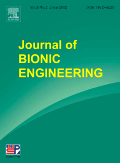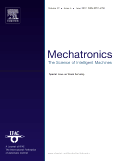
Journal of Bionic Engineering
Scope & Guideline
Exploring the Intersection of Nature and Technology
Introduction
Aims and Scopes
- Bionic Design and Engineering Solutions:
The journal publishes research on the design of systems and components that mimic biological structures and functions, leading to innovative engineering solutions. - Robotics and Automation:
A significant focus is on bio-inspired robotics, including the development of robots that replicate animal movements, functionalities, and adaptive behaviors. - Materials Science and Engineering:
Research on materials inspired by biological systems, including the development of new composites and structures that emulate the properties of natural materials. - Control Systems and Algorithms:
The journal features studies on advanced control systems and algorithms inspired by biological processes, enhancing the performance of robotic and automated systems. - Healthcare and Rehabilitation Technologies:
There is a strong emphasis on applications in healthcare, including prosthetics, exoskeletons, and rehabilitation technologies that leverage bionic principles. - Sensor Development and Optimization:
Research on the development of sensors and sensing technologies inspired by biological systems, contributing to advancements in various applications.
Trending and Emerging
- Soft Robotics and Flexible Systems:
There is a notable trend towards soft robotics, focusing on flexible materials and structures that mimic the softness and adaptability of biological organisms. - Artificial Intelligence in Bionic Systems:
The integration of artificial intelligence and machine learning techniques into bionic engineering is gaining momentum, allowing for more sophisticated control and learning-based applications. - Bio-inspired Energy Harvesting Technologies:
Research on energy harvesting systems inspired by biological mechanisms is emerging, focusing on sustainable and efficient energy solutions. - 3D Printing and Fabrication Techniques:
Advancements in additive manufacturing and 3D printing technologies are increasingly being applied to create complex bionic structures, facilitating innovative designs. - Multiscale and Multimaterial Approaches:
Emerging studies are focusing on the development of multiscale and multimaterial systems that combine various biological and synthetic materials for enhanced functionality. - Sustainable and Eco-friendly Materials:
There is a growing emphasis on the development of sustainable materials inspired by nature, aiming to reduce environmental impact while enhancing performance.
Declining or Waning
- Traditional Mechanical Systems:
Research focusing solely on traditional mechanical systems without bio-inspired elements is becoming less common as the field advances towards more integrated and intelligent designs. - Basic Biological Studies:
Papers that concentrate primarily on basic biological studies without a clear application to engineering or technology are seeing reduced representation in the journal. - Static Design Approaches:
Static design methodologies that do not incorporate adaptive or dynamic elements inspired by biological systems are declining, as there is a growing preference for designs that mimic the adaptability of living organisms.
Similar Journals

Journal of Micro-Bio Robotics
Connecting Robotics with Biological InsightsThe Journal of Micro-Bio Robotics, published by SPRINGER HEIDELBERG, is an esteemed periodical dedicated to the dynamic intersection of robotics and biological systems. With an ISSN of 2194-6418 and an E-ISSN of 2194-6426, this journal spans a broad spectrum of interdisciplinary research from 2013 to 2024, reflecting its commitment to advancing knowledge in fields such as biomedical engineering, biotechnology, electrical and electronic engineering, materials science, and mechanical engineering. This journal holds a Q4 ranking in Biomedical Engineering and a Q3 ranking in several other critical categories, demonstrating its growing influence within the scientific community. The journal serves as a vital resource for researchers, professionals, and students aiming to explore cutting-edge developments in micro-bio robotics, providing a platform for high-impact research that helps facilitate innovation and collaboration in this emerging field. While currently not offering Open Access options, the journal's rigorous peer-review process ensures the highest quality of published work, making it an essential tool for anyone looking to stay abreast of advancements in micro-bio robotic technology.

MECHATRONICS
Unveiling Cutting-Edge Research in Mechatronic SystemsMECHATRONICS is a prominent journal published by PERGAMON-ELSEVIER SCIENCE LTD, focusing on the interdisciplinary fields of mechanical engineering, control and systems engineering, electrical and electronic engineering, and computer science applications. With an ISSN of 0957-4158, this journal has been a cornerstone in advancing knowledge and innovation since its inception in 1991. Known for its rigorous peer-review process and high-quality research outputs, MECHATRONICS holds prestigious rankings, including Q1 in both Electrical and Electronic Engineering and Mechanical Engineering for the year 2023, reflecting its influential position in the academic community. The journal caters to a diverse audience of researchers, professionals, and students, making it an essential resource for those looking to stay at the forefront of technological advancements in mechatronic systems. Although it does not currently offer open access, its wealth of insights and findings is indispensable for anyone pursuing excellence in engineering methodologies and applications.

Journal of Engineering-JOE
Transforming Knowledge into Engineering ExcellenceThe Journal of Engineering-JOE, published by WILEY, is a leading Open Access journal established in 2013 that caters to the dynamic field of engineering. With a focus on disseminating high-quality research, JOE provides a platform for scholars, professionals, and students to share innovative findings across various engineering disciplines, including but not limited to civil, mechanical, electrical, and environmental engineering. The journal's commitment to accessibility allows for the wide distribution of knowledge, ensuring that groundbreaking research reaches a global audience. With the advantage of Open Access, articles published in JOE are freely available, fostering enhanced collaboration and engagement within the engineering community. The journal plays a crucial role in bridging academic findings with practical applications, making it an essential resource for those seeking to stay at the forefront of engineering advancements.

Control Engineering and Applied Informatics
Unlocking New Dimensions in Control Technologies and ApplicationsControl Engineering and Applied Informatics, published by the Romanian Society for Control Technology and Informatics, serves as a pivotal platform for disseminating research and advancements within the fields of control engineering and applied informatics. With an ISSN of 1454-8658, this journal focuses on integrating theoretical developments and practical applications in the context of both electrical engineering and computer science. Although it currently holds a Q4 ranking in both Computer Science (miscellaneous) and Electrical and Electronic Engineering categories, its commitment to fostering interdisciplinary collaboration and innovation makes it a noteworthy publication for researchers and professionals aiming to explore emerging trends and solutions in control systems. Situated in Romania, the journal has a converged publication timeline from 2010 to 2024, providing a rich archive of information for those invested in the scientific community. Readers are encouraged to access this journal to remain at the forefront of cutting-edge research and contribute to ongoing discussions in the field.

FME Transactions
Pioneering insights in Mechanical Engineering and Materials Science.FME Transactions is a distinguished open-access journal published by the Faculty of Mechanical Engineering, University of Belgrade, that has been making significant contributions to the fields of Mechanical Engineering and Mechanics of Materials since its inception in 2002. The journal holds an impressive Q2 classification in Mechanical Engineering and Q3 in Mechanics of Materials as of 2023, highlighting its critical role in advancing engineering knowledge and technology. With an extensive distribution in both print (ISSN: 1451-2092) and online formats (E-ISSN: 2406-128X), FME Transactions emphasizes high-quality, peer-reviewed research that addresses contemporary challenges faced by engineers and material scientists. Positioned within the 59th percentile of its category in Scopus rankings for Mechanical Engineering and at 54th percentile for Mechanics of Materials, the journal is a go-to resource for researchers, professionals, and students seeking to enhance their understanding and application of cutting-edge engineering principles. The journal’s commitment to open access ensures that its valuable findings are readily available to a global audience, fostering collaboration and innovation in engineering practices.

Results in Engineering
Fostering Collaboration and Innovation in Engineering DisciplinesResults in Engineering is an esteemed open-access journal published by Elsevier, dedicated to advancing the field of engineering through high-quality, innovative research. Since its inception in 2019, this journal has rapidly established itself within the academic community, evidenced by its prestigious Q1 ranking in the Engineering (miscellaneous) category for 2023 and a remarkable ranking of #54 out of 307 in General Engineering according to the Scopus database, placing it in the 82nd percentile of its category. Located in the Netherlands, Results in Engineering provides a global platform for researchers, professionals, and students to disseminate their findings and foster collaboration across diverse engineering disciplines. The journal's commitment to open access ensures that valuable research is accessible to a wider audience, fostering innovation and knowledge sharing. With a progressive approach to publication, Results in Engineering seeks to enhance the engineering landscape by publishing cutting-edge studies that address contemporary challenges and solutions in the field.

Australian Journal of Mechanical Engineering
Advancing Mechanical Engineering Knowledge for Tomorrow's Innovations.The Australian Journal of Mechanical Engineering is a distinguished publication in the realm of mechanical engineering, dedicated to advancing the knowledge and application of engineering principles within the industry. Published by TAYLOR & FRANCIS LTD in the United Kingdom, this journal has been integral to the field since its inception, featuring a range of peer-reviewed research articles, reviews, and technical notes that collectively aim to bridge theoretical research with practical applications. With an impressive Scopus ranking of #271 out of 672 in Mechanical Engineering, positioning it within the 59th percentile, the journal continues to uphold rigorous academic standards, currently occupying Q3 in the 2023 quartile rankings. Researchers, professionals, and students alike will benefit from its comprehensive coverage and insightful contributions, providing a vital platform for knowledge exchange and innovation in mechanical engineering.

Industrial Robot-The International Journal of Robotics Research and Application
Unleashing the Future of Robotics and AutomationIndustrial Robot-The International Journal of Robotics Research and Application is a premier academic journal published by Emerald Group Publishing Ltd in the United Kingdom. Since its inception in 1973, the journal has established itself as a critical resource for the advancement of knowledge in the fields of robotics and automation. With an impressive Q2 ranking across several categories, including Computer Science Applications, Control and Systems Engineering, and Industrial and Manufacturing Engineering, it places itself among the top-tier journals in its domain. The journal aims to disseminate high-quality research that addresses contemporary challenges and innovations in robotics, thereby supporting both academic inquiry and practical applications in industry. Researchers, professionals, and students are encouraged to contribute to its mission, as it remains vital for those seeking to engage with the ever-evolving landscape of robotic technologies.

Science Robotics
Elevating Robotics to New Heights of ExcellenceScience Robotics, published by the American Association for the Advancement of Science, is a leading journal that explores cutting-edge advancements in the field of robotics, emphasizing the intersection of artificial intelligence, mechanical engineering, and control optimization. With its ISSN 2470-9476, this prestigious journal holds an impressive Q1 ranking across pivotal categories for 2023, including Artificial Intelligence, Computer Science Applications, Control and Optimization, and Mechanical Engineering. It has garnered renowned recognition in the academic community, highlighted by its high Scopus rankings—placing it in the top tier with a 99th percentile rank in Mathematics for Control and Optimization and Computer Science Applications, and maintaining a 98th percentile in Artificial Intelligence. While the journal is not currently open access, it serves as a vital repository of knowledge for researchers, professionals, and students seeking to stay at the forefront of robotic innovations. Operating from its base in Washington, DC, Science Robotics aims to disseminate world-class research that catalyzes future developments in robotics and automation technologies, making it an essential resource for those engaged in the scientific study and application of these transformative fields.

INTERNATIONAL JOURNAL OF ROBOTICS & AUTOMATION
Connecting Scholars in Robotics and Systems Engineering.International Journal of Robotics & Automation is a premier academic journal published by ACTA PRESS, dedicated to advancing knowledge and applications in the dynamic fields of robotics, automation, and related engineering disciplines. With a history spanning from 1995 to 2024, this journal serves as a crucial platform for the dissemination of innovative research, offering valuable insights across various categories, including Artificial Intelligence, Control and Systems Engineering, and Mechanical Engineering. Although currently not open access, its rigorous peer-reviewed articles hold significance for researchers, professionals, and students alike, providing a solid foundation for advancements in technology and engineering methodologies. The journal's rankings in Scopus reflect its growing impact, particularly in niche areas of Modeling and Simulation and Software, highlighting the critical need for cutting-edge research and discussion in these developing fields. As the landscape of robotics and automation continues to evolve, this journal remains an essential resource for those seeking to contribute to and engage with the forefront of scholarly research.